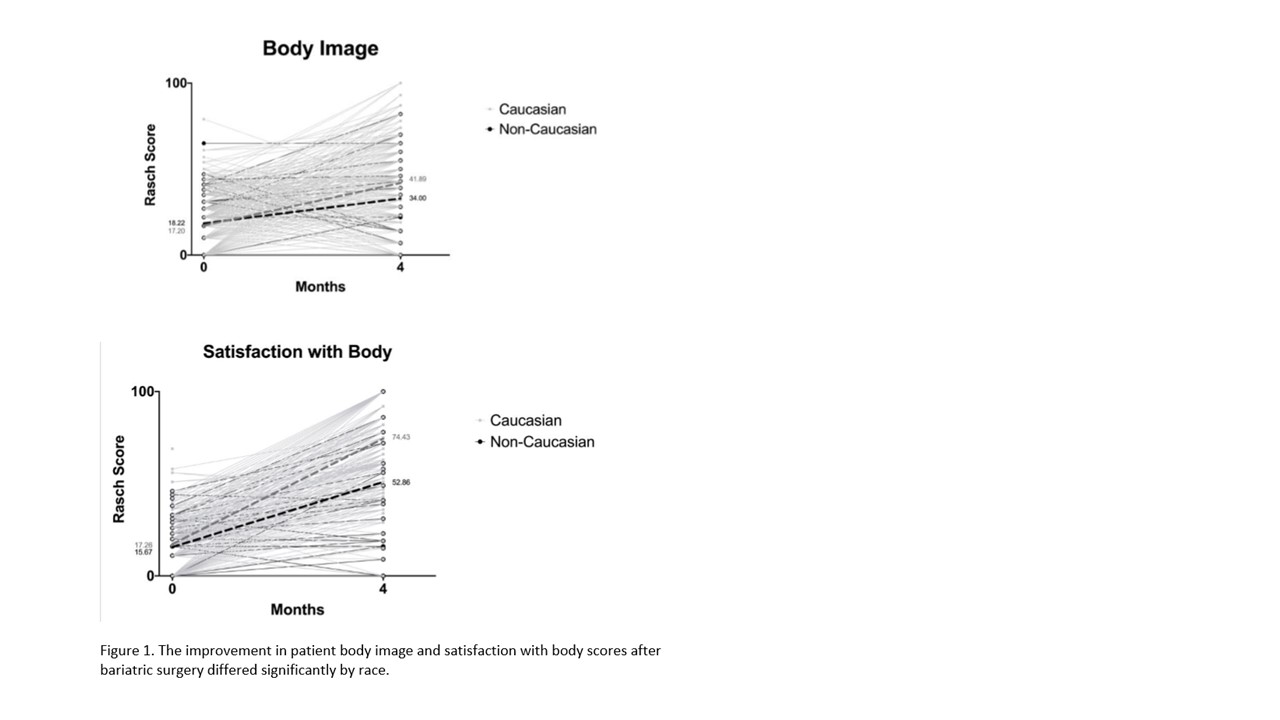Racial Disparities in Body Image Satisfaction following Bariatric Surgery
*Danny Mou1, *Claire de Vries1, *Rene Wiezer2, *Simon Nienhuijs3, *Ronald Liem4, *Maarten Hoogbergen3, *Dennis Makarawung5, *Regan Bergmark1, *Anne Klassen6, Ali Tavakkoli1, *Andrea Pusic1, *RN van Ween7
1Brigham and Women's Hospital, Boston, MA;2Sint Antonius Ziekenhuis, Gouda, Netherlands3Catharina Ziekenhuis, Eindhoven, Netherlands4Groene Hart Hospital, Gouda, Netherlands5Sint Antonius Ziekenhuis, Nieuwegein, Netherlands6McMasters University, Hamilton, ON, Canada7OLVG West, Amsterdam, Netherlands
Background
Bariatric surgery has the potential to improve body image and appearance as measured by patient reported outcomes (PROs). However, there may differences in body image satisfaction based on race.
Design:
PRO data was measured with the BODY-Q, a PRO instrument designed for bariatric surgery patients. Linear mixed models were used to analyze associations with race and BODY-Q outcomes from preoperative to 4 months postoperatively.
Patients:
The sample included participants from a multicenter, prospective, longitudinal cohort study collecting clinical and PRO data before and after bariatric surgery.
Intervention:
Patients completed the BODY-Q instrument before and after surgery
Main outcome Measures:
Primary endpoints included PRO scores reflecting body image, satisfaction with body, buttocks, hips/thighs, and abdomen.
Results
We analyzed 564 bariatric surgery patients. Non-Caucasians had lower age (p < 0.0001), higher rates of hypertension (p=0.009) and osteo-articular disease (p < 0.0001). There were no significant differences in BODY-Q scores before bariatric surgery. While weight loss at 4 months was similar between Caucasians and non-Caucasians, Caucasians improved significantly more on BODY-Q scales measuring body image (p = 0.014) and satisfaction with body (p < 0.001), buttocks (p = 0.001), hips and outer thighs (p = 0.011) and abdomen (p = 0.014).
Conclusions
Body image and satisfaction with appearance following bariatric surgery varied significantly by race. These data suggest the existence of different standards of preferred body types.
| Caucasian (n=453) | Non-caucasian (n=111) | P | ||
| Preoperative | ||||
| Mean age (years) | 46 | 37 | <0.0001 | |
| Female | 374 | 100 | 0.347 | |
| Mean BMI (kg/m2) | 43 | 44 | 0.278 | |
| Bariatric surgery | ||||
| Procedure type | 0.370 | |||
| Primary gastric bypass | 276 | 63 | ||
| Primary sleeve gastrectomy | 150 | 42 | ||
| Revisional surgery | 11 | 2 | ||
| 4-months post-operative | ||||
| % TWL (4 months) | 21.9 | 20.2 | 0.070 | |
| BMI change | -9.35 | -8.65 | 0.209 |

Back to 2019 Posters




